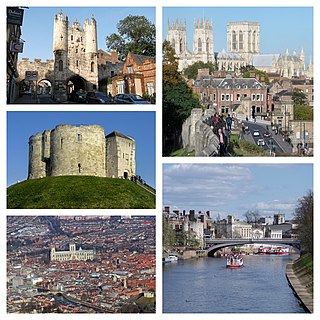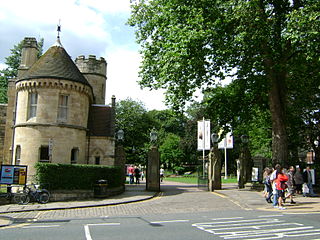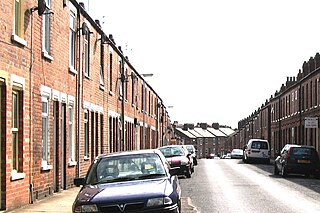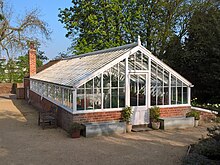
York is a cathedral city in North Yorkshire, England, with Roman origins, sited at the confluence of the rivers Ouse and Foss. It is the county town of Yorkshire. The city has many historic buildings and other structures, such as a minster, castle, and city walls. It is the largest settlement and the administrative centre of the wider City of York district.

Castle Howard is a stately home in North Yorkshire, England, within the civil parish of Henderskelfe, located 15 miles (24 km) north of York. It is a private residence and has been the home of the Carlisle branch of the Howard family for more than 300 years. Castle Howard is not a fortified structure, but the term "castle" is sometimes used in the name of an English country house that was built on the site of a former castle.

Dringhouses is a suburb of York, in the ceremonial county of North Yorkshire, England. Historically part of the West Riding of Yorkshire, it is bounded by the Knavesmire, an open area of land on which York Racecourse is situated, to the east, Askham Bog and the A64 to the south, Woodthorpe and Foxwood to the west, and Acomb and Holgate to the north. It is part of the City of York ward is called Dringhouses and Woodthorpe which covers an area of 4.3 km2 (1.7 sq mi) and had a population of 11,084 at the 2011 Census. It is located approximately two and quarter miles from York City Centre.

Wakehurst, previously known as Wakehurst Place, is a house and botanic gardens in West Sussex, England, owned by the National Trust but used and managed by the Royal Botanic Gardens, Kew. It is near Ardingly, West Sussex in the High Weald, and comprises a late 16th-century mansion, a mainly 20th-century garden and, in a modern building, Kew's Millennium Seed Bank. Visitors are able to see the gardens, the mansion, and also visit the seed bank. The garden today covers some 2 km2 and includes walled and water gardens, woodland and wetland conservation areas.

Elsham Hall is a 17th-century English country house situated in its own parkland in Elsham, North Lincolnshire. The park and gardens are open to the public.

Thornton-le-Dale is a village and civil parish in North Yorkshire, England, about 3 miles (5 km) east of Pickering on the edge of the North York Moors National Park. The area of the village encompasses 39.2 square kilometres.

Dyrham Park is a baroque English country house in an ancient deer park near the village of Dyrham in South Gloucestershire, England. The house, with the attached orangery and stable block, is a Grade I listed building, while the park is Grade II* listed on the National Register of Historic Parks and Gardens.

Terry's is a British chocolate and confectionery brand. The original company was founded in 1767 in York, England, and was part of the city's famous confectionery triumvirate along with Rowntree's and Cravens. The company's headquarters and factory, Terry's Chocolate Works, was closed by Kraft in 2005 and production moved to Kraft factories in Europe. The business returned to the UK in 2019 as Terry's Chocolate Co located in London. Their best known products include Terry's Chocolate Orange and Terry's All Gold box of assorted chocolates which were both introduced in the 1930s.

The York Museum Gardens are botanic gardens in the centre of York, England, beside the River Ouse. They cover an area of 10 acres (4.0 ha) of the former grounds of St Mary's Abbey, and were created in the 1830s by the Yorkshire Philosophical Society along with the Yorkshire Museum which they contain.

South Bank is an area of York in the county of North Yorkshire, England. It is to the south of the River Ouse. It was home to the now-closed Terry's Chocolate Works.

Walter Henry Brierley (1862–1926) was a York architect who practised in the city for 40 years. He is known as "the Yorkshire Lutyens" or the "Lutyens of the North". He is also credited with being a leading exponent of the "Wrenaissance" style - incorporating elements of Christopher Wren.

Beningbrough Hall is a large Georgian mansion near the village of Beningbrough, North Yorkshire, England, and overlooks the River Ouse.

Blackwell is a large house in the English Lake District, designed in the Arts and Crafts style by Baillie Scott. It was built in 1898–1900, as a holiday home for Sir Edward Holt, a wealthy Manchester brewer. It is near the town of Bowness-on-Windermere with views looking over Windermere and across to the Coniston Fells.

Sir Joseph TerryJP was a British confectioner, industrialist and Conservative politician who served as Lord Mayor of York on three occasions. He had previously served as a deputy mayor through his role as town sheriff in 1870, and served as Councillor for York's Monk Ward from 1860 until this appointment. He further acted as a Justice of the Peace for both the City of York and the North Riding of Yorkshire from 1887 until his death.

Fairfax House is a Georgian townhouse located at No. 27, Castlegate, York, England, near Clifford's Tower and York Castle Museum. It was probably built in the early 1740s for a local merchant and in 1759 it was purchased by Charles Gregory Fairfax, 9th Viscount Fairfax of Emley, who arranged for the interior to be remodelled by John Carr (architect). Fairfax was the widower of heiress Elizabeth Clifford, daughter of Hugh Clifford, 2nd Baron Clifford of Chudleigh: his inheritance from her death enabled him to purchase the house, which he intended as a home for his daughter from his first marriage, Ann Fairfax.
Brierley Groom is an architecture practice in York, England, founded in 1750 by architect John Carr, making it the longest running practice in the United Kingdom, and one of the oldest in the world. It was once run by Walter Brierley, known for having created over 300 buildings in the York area and across the north of England. The company has won several design awards. The practice operates from an office in York and is currently owned by brothers, partners and chartered architects Greg and Matthew Groom.

George Russell (1857–1951) was born in Stillington and lived in York, England. He is most notable for his work developing the Russell Hybrid Lupins. A gardener by occupation, he began experimenting with Lupins in his fifties, after being inspired by the sight of a vase of the flowers at the home of one of his employers.

Bishopsbarns is a historic house in south-west York, in England.

Bishopthorpe Garth is a grade II listed house on the edge of Bishopthorpe, a village south of York, in England.























